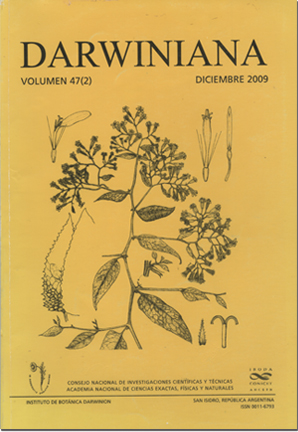Micromorphological characters supporting the removal of Senecio series Otopteri from Senecio (Asteraceae, Senecioneae)
DOI:
https://doi.org/10.14522/darwiniana.2014.472.65Keywords:
Asteraceae, Compositae, micro-morphology, section Otites, Senecio, series Otopteri, South AmericaAbstract
Recent molecular studies suggest that Senecio otites belonging to Senecio sect. Senecio ser. Otopteri should be removed from Senecio so that this large and taxonomically complicated genus would be monophyletic. In order to evaluate the taxonomic position of Senecio otites and the placement of series Otopteri, 13 species belonging to Senecio sect. Senecio ser. Otopteri, including S. otites, were examined for micro-morphological characters of the style branches (stigmatic surface, style-arm apices) and anthers (filament collar, anther bases, anther appendages). Three states of these micromorphologicalcharacters were present in nearly all species of Senecio sect. Senecio ser. Otopteri: 1) the style-arms are apically convex or subconvex, papillate, and surrounded by a crown of hairs of different lengths; 2) the stigmatic surfaces have a cleft configuration (banded to cleft in S. attenuatus); and 3) the anthers are auriculate. These results provide new morphological support for the placement of Senecio otites in Senecio sect. Senecio ser. Otopteri and the future removal of that series from Senecio proper.
Downloads
Published
31-12-2009
How to Cite
Riva, A., Pozner, R., & Freire, S. E. (2009). Micromorphological characters supporting the removal of Senecio series Otopteri from Senecio (Asteraceae, Senecioneae). Darwiniana, Nueva Serie, 47(2), 327–334. https://doi.org/10.14522/darwiniana.2014.472.65
Issue
Section
Systematics and Taxonomy of Plants
License

Starting on 2012, Darwiniana Nueva Serie uses Licencia Creative Commons Atribución-NoComercial 2.5 Argentina .






